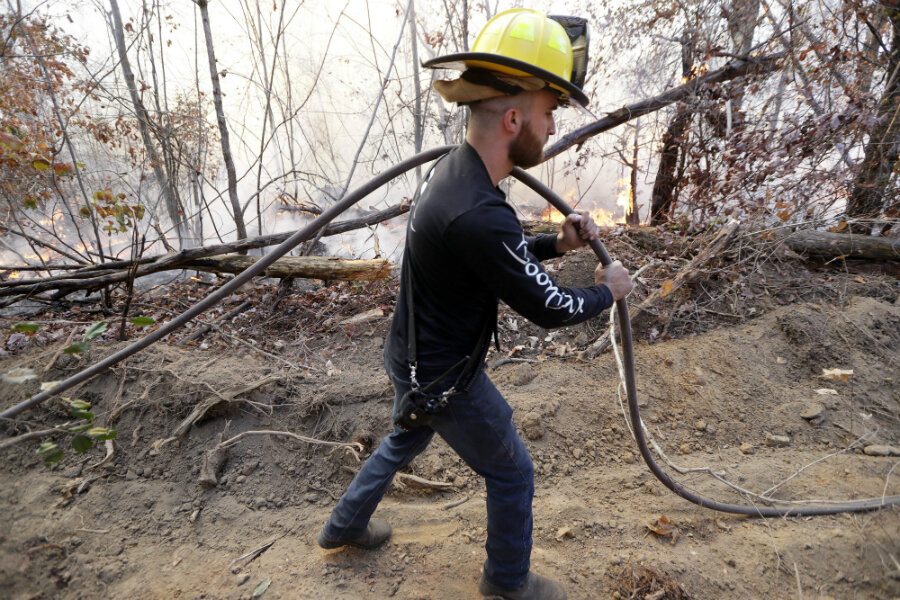At least 20 wildfires sweeping Southeast suspected of arson
Loading...
| Atlanta
At least 20 wildfires in North Carolina are being investigated as suspected arson, officials said, as firefighters from across the country focused a pocket of fires in the bone-dry southern Appalachian mountains.
A division of the US Forest Service said fires have been burning on more than 25 square miles in the Nantahala National Forest in the western part of North Carolina. Across the South, relentless drought has turned pine trees into matchsticks and forced people from their homes in dozens of communities.
More than 5,000 firefighters and support staff from around the nation are trying to suppress these fires, said Shardul Raval, director of fire and aviation management for the southern region of the US Forest Service.
The effort includes about 40 aircraft, including three large air tankers flying out of Chattanooga, Tenn. Tens of thousands of acres of forest have burned and about a dozen of the largest fires were uncontained, the forest service said.
High winds and temperatures and weeks without rain have combined to spark blaze after blaze in the unusually dry landscape. Numerous teams reported wind-driven fires racing up slopes and down ravines as they struggled to protect hundreds of threatened structures.
"It just smells like a campfire" along the Appalachian Trail in north Georgia, said Carlie Gentry, who works at the Mountain Crossings store at Walasi-yi, a popular stop for hikers.
"For weeks up here we've been having smoke, but it is getting more intense for sure," Gentry said. Typically, the view stretches for miles, she said. Now, "you can hardly see to the next ridge."
The national drought report shows 41.6 million people in parts of 15 Southern states living in drought conditions. The worst is in Georgia, Alabama, Mississippi, and Tennessee, but extreme drought also is spreading into the western Carolinas. Kentucky, Tennessee, and North Carolina all have fierce fires.
"Right now we're kind of holding our own," said Jennifer Turner, a spokeswoman for the Kentucky's state Division of Forestry. "We've been able to get control over some of the smaller fires."
But with humidity so low in the normally lush Appalachians and Great Smoky Mountains, authorities are bracing for more. North Carolina's Gov. Pat McCrory declared a state of emergency for a fourth of his state's 100 counties, to help with evacuations and provide more firefighting assets.
More than 560 firefighters and staff from at least 40 states were battling 18 blazes in the Nantahala National Forest in western North Carolina, and state climatologist Rebecca Ward said some counties are having one of their driest years in 105 years of record-keeping.
"Additional crews, engines, helicopters and air tankers continue to arrive from all across the country to help with the firefighting effort," fire managers told residents Thursday.
Kentucky authorities made two arson arrests and cited another man for causing a brush fire by defying a burn ban. Tennessee authorities also reported arrests for arson and burning violations.
Smoke blowing southward has blanketed Atlanta and other cities in haze.
Alabama extended its ban throughout the state, where drought is choking 80 percent of the land, drying up streams and lakes and turning plants to tinder. Firefighters in Alabama have battled more than 1,100 fires that have charred nearly 12,000 acres in the last month.
One of the largest blazes was spreading rapidly in the Cohutta Wilderness area just south of the Georgia-Tennessee line. Nearly 300 people are battling that fire, which already consumed about 15 square miles, the Forest Service said.
In the hills outside Chattanooga, firefighters were trying to save homes on both Signal Mountain and Mowbray Mountain. They may get reinforcements: The Federal Emergency Management Agency said it would reimburse most of one fire's costs after a request from Tennessee.
Dai Harris, 29, was staying in a local firehouse after being evacuated from his home near Mowbray Mountain. "There's a lot of smoke, and it's covering a broad area, so I assume there's still quite a bit of flames out there," he said.
"I'm getting very concerned, mainly for my neighbors," Mr. Harris said. "I'm concerned about their houses now. I'm afraid they're not going to come home to one."
Associated Press writers Martha Waggoner in Raleigh, North Carolina; Jonathan Mattise in Nashville, Tennessee; Jay Reeves in Birmingham, Alabama; Bruce Schreiner in Frankfort, Kentucky; and Jack Jones in Columbia, South Carolina; contributed to this report.







